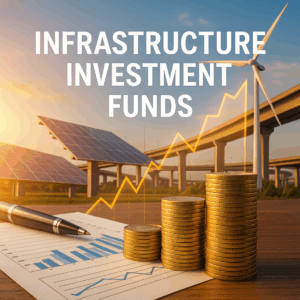Infrastructure investment funds are pooled investment vehicles that allocate capital to essential physical assets, such as transportation networks, utilities, and communication systems, with the goal of generating stable, long-term income.
These funds offer investors exposure to real-world infrastructure projects that often have inflation-linked revenues and lower correlation to traditional markets.
This article breaks down the essentials of infrastructure funds by addressing:
- What do infrastructure investment funds mean?
- Are infrastructure funds a good investment?
- What are the strategies for infrastructure funds?
- What is the difference between an investment fund and an investment trust?
If you are looking to invest as an expat or high-net-worth individual, which is what I specialize in, you can email me (hello@adamfayed.com) or WhatsApp (+44-7393-450-837).
This includes if you are looking for a free expat portfolio review service to optimize your investments and identify growth prospects.
Some facts might change from the time of writing. Nothing written here is financial, legal, tax, or any kind of individual advice, nor is it a solicitation to invest or a recommendation of any specific product or service.

What Is an Infrastructure Fund?
An infrastructure fund is an investment scheme that allocates capital to infrastructure assets and focuses on essential community services and critical facilities.
These include transport networks, utilities, communication systems, and social infrastructure like schools or hospitals.
Investors benefit from steady cash flows generated by user fees, long-term contracts, or government-backed revenues.
Key Features
- Typically structured as mutual funds, ETFs, or private equity-style vehicles
- Focused on income generation, stability, and inflation resilience
- Can invest in both developed and emerging markets
What is the difference between direct investment and fund investment?
Unlike direct infrastructure investment, which involves buying and managing physical assets (often requiring large capital and long time horizons), infrastructure funds offer diversified, professionally managed exposure.
Investors can access the sector without assuming the operational burdens or illiquidity of owning assets outright.
What is an example of an infrastructure investment?
- Transport: Toll roads, railways, airports
- Energy: Power generation, transmission lines, pipelines
- Telecommunications: Fiber networks, data centers, towers
- Social infrastructure: Hospitals, water treatment plants, educational facilities
Is It Good to Invest in Infrastructure Funds?
Infrastructure funds offer a balance of income, growth, and diversification, but they are best used as part of a broader investment strategy rather than a standalone solution.
Long-Term Income Potential and Inflation Protection
Infrastructure assets often operate under long-term contracts or regulated frameworks.
This leads to predictable cash flows and dividend distributions, making infrastructure funds particularly attractive for income-focused investors.
Many of these assets also have revenues that are linked to inflation indexes, helping preserve purchasing power over time.
Risk Profile and Market Correlation
Infrastructure funds tend to have a moderate risk profile.
They are generally less volatile than equity markets, especially during economic downturns, due to the essential nature of the underlying assets.
That said, they can still be affected by:
- Regulatory changes
- Political risk
- Interest rate fluctuations
- Project-specific challenges
Their correlation with broader equity markets is low to moderate, making them useful for diversification within a balanced portfolio.
Who Infrastructure Funds Are Best Suited For
Infrastructure funds are especially well-suited for:
- Retirees and income-seeking investors looking for steady cash flows
- Long-term investors interested in capital preservation with moderate growth
- Diversified portfolios that need exposure to real assets without direct ownership
Overall, whether infrastructure funds are a good fit depends on your investment goals, risk tolerance, and market outlook.
What Are the Strategies for Infrastructure Funds?
Infrastructure funds typically follow four main strategies: core, core plus, value-added, and opportunistic. Each comes with different risk and return profiles.

- Core strategies focus on established, income-generating infrastructure assets such as toll roads, utilities, and power transmission. These assets typically offer stable returns with lower risk and minimal operational involvement.
- Core plus strategies have slightly more risk than core, with potential for moderate capital appreciation. It may include assets with minor development, operational improvements, or some demand variability.
- Value-added strategies involve assets that may require operational improvements or moderate development. They offer higher return potential than core assets but carry moderate risk.
- Opportunistic strategies target assets with significant development or turnaround needs. These may include greenfield projects or assets in emerging markets. While they offer the highest return potential, they also come with elevated risk and volatility.
Geographic and Sector Diversification
Diversification is a key risk-management tool in infrastructure investing. Funds may spread investments across:
- Regions (e.g., North America, Europe, Asia-Pacific, emerging markets)
- Sectors (e.g., transport, renewable energy, digital infrastructure, water and waste)
This approach helps mitigate risks related to local regulations, economic cycles, and sector-specific downturns.
Publicly Traded vs. Private Infrastructure Funds
- Public infrastructure funds invest in listed infrastructure companies or trusts, offering greater liquidity and lower entry barriers. They’re suitable for retail investors who want easy access and daily pricing.
- Private infrastructure funds typically require higher minimum investments and are often limited to institutional or accredited investors. They invest directly in assets or via private partnerships, providing longer-term exposure and less price volatility, but also lower liquidity.
A well-chosen infrastructure fund strategy can enhance both returns and resilience in a diversified portfolio.
What Is the Best Infrastructure Fund to Invest In?
Identifying the best infrastructure fund depends on your investment goals, risk tolerance, and access to various fund types.
While there’s no one-size-fits-all answer, here are key factors to consider when evaluating infrastructure funds:
Factors to Consider in Choosing the Best Infrastructure for You
- Management fees and expense ratio: Lower fees can enhance long-term returns, but be sure they don’t come at the cost of performance or oversight.
- Performance track record: Look for funds with consistent returns through various market cycles and economic conditions.
- Sector exposure and geographic diversification: Some funds focus heavily on renewable energy, transport, or digital infrastructure. A balanced approach may reduce risk.
- Liquidity and fund structure: Publicly traded funds offer ease of entry and exit, while private funds may require lock-in periods and higher minimums.
How to Invest in Infrastructure Investment Funds
You can invest in infrastructure funds through brokerages, ETFs, mutual funds, or pension plans, depending on your goals and investor status.
Here’s how to get started:
Direct Investment Through Brokerages or Wealth Platforms
Most publicly traded infrastructure funds can be purchased through standard brokerage accounts or digital wealth platforms.
These platforms often offer tools for comparing fund performance, fees, and asset allocation.
Investing via Pension Plans, ETFs, or Mutual Funds
Many pension plans and retirement accounts offer exposure to infrastructure through dedicated fund options or diversified portfolios that include infrastructure allocations.
- ETFs: Provide liquidity, lower fees, and diversified exposure to global infrastructure companies.
- Mutual funds: Typically offer active management and may focus on specific sectors like utilities, transport, or energy.
Minimum Capital and Access Requirements
- Public funds often have low minimums, making them accessible to individual investors.
- Private infrastructure funds usually require significant capital and may have limited entry windows.
- Institutional products may only be available to qualified or accredited investors due to regulatory restrictions.
Infrastructure Investment Funds vs. Infrastructure Investment Trusts
While both infrastructure investment funds and infrastructure investment trusts (InvITs) provide access to infrastructure assets, they differ in structure, regulation, and investor experience.
Structural and Regulatory Differences
- Infrastructure Investment Funds are typically pooled investment vehicles such as mutual funds, ETFs, or private equity funds, that invest in infrastructure-related companies or projects. These can be actively or passively managed and vary in regulation depending on domicile and structure.
- InvITs are structured as trusts that directly hold infrastructure assets and generate income from them. They are governed by specific financial market regulators and must meet strict distribution and asset ownership criteria.
Liquidity, Returns, and Suitability Comparisons
- Liquidity:
- Public infrastructure funds (e.g., ETFs) tend to offer higher liquidity due to exchange listing.
- InvITs also trade on stock exchanges but may have lower volumes depending on the market.
- Private funds have limited liquidity and longer lock-in periods.
- Returns:
- InvITs often prioritize regular distributions and stable cash flows.
- Funds may focus on total return, including capital appreciation, depending on strategy.
- Suitability:
- Funds are suitable for retail and institutional investors seeking diversified, liquid access.
- InvITs appeal to income-focused investors with a longer-term, yield-driven outlook.
Understanding your risk profile, income needs, and time horizon can help determine which vehicle better fits your investment strategy.
Are Infrastructure Funds Right for You?
Infrastructure funds offer steady income and diversification, but come with varying risks and strategies.
Align your choice with your goals and risk profile.
For best results, seek professional advice before investing.
Pained by financial indecision?

Adam is an internationally recognised author on financial matters with over 830million answer views on Quora, a widely sold book on Amazon, and a contributor on Forbes.


